Sport Pilot Daze
What’s up with the light-sport ticket, and what/where/when can I fly with it?
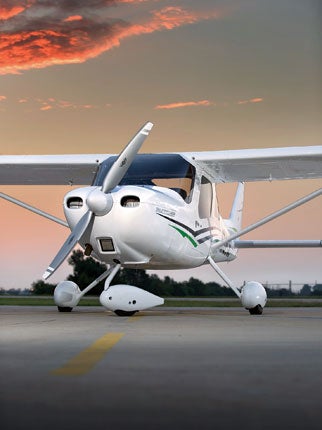 Cessna Skycatcher |
Behold the rapidly beating heart of light-sport aviation: A YouTube video chronicles a pilot's dead-stick takeoff. Not landing...takeoff. He points his engine-off LSA down a 35-degree mountain slope, rolls into a hang glider--style launch and lands---still dead stick---on a sandbar 1,500 feet below and two miles away.
A young journalist who has never flown in a light plane gets his sport pilot license in seven days and 34 hours in a composite LSA that cruises at 120 knots and lands at 45.
Fully recovered from open-heart surgery, a retired 35,000-hour airline pilot spends a week in his new Piper Cub LSA deep in Idaho's Sawtooth Mountains, shooting landings and takeoffs from some of the most rugged dirt strips in the world.
An LSA gyrocopter leaps from a narrow dirt road in a huge swirl of sand. The pilot is halfway through her weeklong photographic exploration of remote, off-road Indian archaeological sites in the desert Southwest.
Crank Up The Flivver, Betsy!
These snapshots of light-sport aviation reveal the real-world face of the revolution in personal general aviation known as light-sport aircraft, LSA for short.
Thanks to the new sport pilot rule---which makes it easier than ever to get your wings without having to fly a well-used plane that smells like old gym socks soaked in stale gas---student pilots are now learning in sharp, shiny new airplanes with roomy cockpits and superb visibility. Welcome to the new wave of personal flight!
Of course, there are limits to what you can do with the ticket and these birds. You can't go 200 knots or upside down at night in a thunderstorm in an LSA. After all, you're not insane. Which brings us to P&P study hall: What are the sport pilot rule and LSA all about?
A Kinder, Gentler Way To Fly
By FAA decree, an LSA must:
⢠carry a maximum of two occupants. Sorry, no sumo wrestlers in the backseat; there aren't backseats except in two-seat tandems anyway.
⢠have a maximum takeoff weight of 1,320 pounds (seaplanes: 1,430 pounds). That means a useful load of two people and light baggage. See sumo comment above.
⢠fly no faster than 120 knots at maximum continuous power and stall no faster than 45 knots clean. Fighter pilots need not apply.
⢠be powered by one nonturbine engine.
⢠have a fixed or ground-adjustable propeller only.
⢠operate on fixed landing gear. Amphibious floatplanes with retractable wheels are allowed.
⢠be a ready-to-fly special LSA (S-LSA) or an experimental homebuilt LSA (E-LSA).
⢠have N-number registration.
⢠fall within these categories and sets: airplane single-engine (land/sea subsets), glider, lighter-than-air, rotorcraft (gyroplanes only, no helicopters), weight-shift-control (land/sea subsets) and powered parachute. Foot-launched hang gliders and powered parachutes without undercarriages aren't considered LSA.
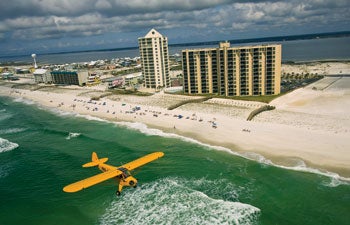 Legend Cub |
So much for the bird, now for the bird person. The sport pilot certificate requires that you:
⢠take ground training from an instructor or home-study course. King Schools (www.kingschools.com) and ASA (www.asa2fly.com) have excellent DVD programs. [Read "Training & Planning Software" in P&P Jan/Feb 2009 for more guidance.]
⢠pass the FAA sport pilot written test.
⢠take a minimum of 20 hours of flight training (15 hours dual, five hours solo). This training must include two hours of cross-country dual training, 10 full-stop takeoffs and landings and one solo cross-country flight that must exceed 75 miles, have three legs (one of at least 25 nm) and consist of full-stop landings on two legs. (Note: Most pilots finish at 35 or more hours.)
⢠have a current, valid driver's license. Flight medical exams are not required, but---and this confuses some people---if you've ever failed a flight medical, you cannot operate an LSA until you clear up the health problem and recertify medically. For pilots who think they might fail a medical, conventional wisdom advises letting the medical certificate expire. Implicit in all FAA pilot certificate regs is the expectation that the pilot in command (PIC), that's you, will always self-declare your physical fitness for flight. If, for any reason, you're not physically able to fly safely, it's your legal, and moral, responsibility to stay on the ground.
⢠prepare for the FAA practical flight test (aka "checkride") with three hours of flight training.
⢠pass the checkride (oral and in-flight) with an FAA examiner. Sure, you'll be nervous. (News flash: If you study and practice, the checkride is a snap.)
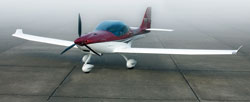 Cirrus SRS |
Now for the operating limitations of the license. As a sport pilot, you can't:
⢠carry a passenger or property for compensation or hire.
⢠carry more than one passenger.
⢠fly at night.
⢠fly in Class A airspace (i.e., above 18,000 feet).
⢠fly in Class B, C or D airspace without required additional training and a logbook endorsement from your flight instructor.
⢠fly outside the United States without prior authorization from the foreign country.
⢠fly higher than 10,000 feet MSL.
The FAA has proposed a rule change, soon to be released. The new wording will be something like "10,000 feet or 2,000 feet AGL, whichever is higher." Rockies, ho!
⢠fly when flight or surface visibility is less than three statute miles and without visual reference to the surface.
 Luscombe |
Now for some nuance. The FAA, by allowing a minimum of only 20 hours for the sport pilot ticket, wants to ensure pilot competency by requiring subsequent training in other aircraft subsets before you're legal to fly those aircraft. One licensing size does not fit all with LSA flight.
In other words, if you become licensed in a weight-shift trike LSA, you're not legal to fly a Legend Cub or a Flight Design CTLS or any other subset type of LSA without the appropriate extra training.
Bottom line: Although the restrictions placed upon the sport pilot certificate improve the odds for safe flight, adopting the "always learning" philosophy of piloting and navigating makes lots of sense. Meanwhile, you can cruise at 120 knots and really go places. For those of us primarily interested in burger-flight fun and adventure travel, alone or with a friend or spousal unit, the restrictions aren't a deal breaker.
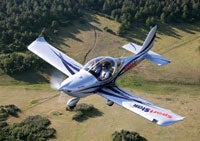 SportStar |
One Giant Leap, Etc.
The sport pilot rule came about from years of work between the FAA and pilot organizations EAA (www.eaa.org) and AOPA (www.aopa.org).
And was it a coincidence that the FAA chose July 20, 2004, to finalize the sport pilot/LSA rule? Did some misty-eyed pucks in bureaucrats' clothing signify their personal faith in the future impact of the new rule by picking that date?
Whatever the case, the 35th anniversary of Neil Armstrong's "one small step" on the moon might---we can hope---augur a giant leap for grassroots aviation. And the FAA has signaled its intention to strengthen the rule with ongoing changes to clarify confusion and minimize inequities.
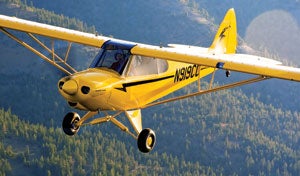 SportCub S2 |
The LSA category currently numbers no less than 87 new aircraft. Rather than requiring rigorous airframe certification testing, the FAA empowered a set of LSA-industry self-certification ASTM regulations (ASTM International is a commercial organization with a century of creating industry "standards"). When a dealer says that the shiny new LSA you want to buy is certified, it means it "conforms" to ASTM standards.
LSA also enfold certain previously FAA-certified, two-seat immortals (such as Piper Cubs, Ercoupes and Luscombes) to be flown by sport pilots.
Keeping It Friendly
One clear purpose of the sport pilot rule is to reverse the long trend toward ever-more-expensive flight training and aircraft ownership. Too many pilots saw their annual flying hours go down as the complexity and costs of flying went up, up, up.
Yet, after some initially attractive prices in the mid-$50,000 range, the median price for LSA aircraft is now closer to $100,000, brought on in large part by the imbalance between the euro and the dollar (because a majority of LSA are built overseas).
Icon A5 |
While that's dampened some of the initial rush to sport pilot flight, it's still vastly more affordable than a typical new general aviation plane of more than three times that price. LSA is the way to go for affordable and fun flight.
Also, typical LSA rental rates are lower than for a Cessna 172, as are hourly operating costs for owners. LSA powered by 100 and 120 hp engines from Rotax, Jabiru, Lycoming and Continental sip fuel at around 5 gph instead of the typical 8 to 10+ gph of conventional aircraft.
That has led to flying clubs popping up again, as well as fractional, or group-owned, financing plans. Pilots who wish to co-own a sleek, fast composite LSA with all the bells and whistles can join with half a dozen like-minded types and finance one for around $20,000 each.
And don't forget those older and cheaper classic aircraft, such as the Piper Cub and Aeronca Champ.
Final word: LSA do require aviating skills to pilot safely. That only makes sense. But most are easy to fly, and once you strap in to that roomy cockpit---many are more than 42 inches wide---you gain other "bennies": comfort and great visibility. Also, noise and vibration levels are usually lower and less fatiguing. Yet, in many new ships, you've got the control sensitivity of a fighter plane coupled with the stability you want in turbulent conditions. Not too shabby.
All in all, it's a great time to be a pilot. Go find a rep and take a demo. You'll be amazed at the sophistication and pure fun that light-sport aircraft bring to the world of flying.

Subscribe to Our Newsletter
Get the latest Plane & Pilot Magazine stories delivered directly to your inbox






